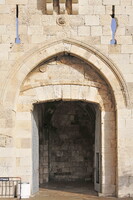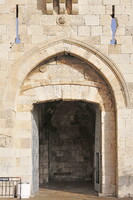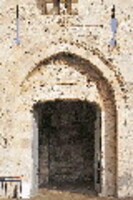| dc.coverage.spatial | Site: Jerusalem, Jerusalem (national district), Israel | en_US |
| dc.coverage.temporal | 1538 (creation); 2007-2010 (restoration) | en_US |
| dc.creator | unknown (Islamic) | en_US |
| dc.date | 1538-1539 | en_US |
| dc.date.accessioned | 2013-12-24T15:08:30Z | |
| dc.date.available | 2013-12-24T15:08:30Z | |
| dc.date.issued | 1538-1539 | en_US |
| dc.identifier | 243668 | en_US |
| dc.identifier.other | archrefid: 2910 | en_US |
| dc.identifier.uri | http://hdl.handle.net/1721.3/152285 | |
| dc.description | Detail of the gate and arrow slots above the pointed arch; Also known as Bab Mihrab Daud, "Gate of the Prayer Niche of David"; also David's Gate. It is one of eight gates in Jerusalem's Old City walls. Jaffa Gate was inaugurated in 1538 as part of the rebuilding of the Old City walls by Suleiman the Magnificent. Jaffa Gate is the only one of the Old City gates positioned at a right angle to the wall. This could have been done as a defensive measure to slow down oncoming attackers, or to orient it in the direction of Jaffa Road, from which pilgrims arrived at the end of their journey from the port of Jaffa. The gate also leads to Hebron, which is why the Arabic name Bab el-Khalil references Abraham, who is buried in Hebron. A section of the wall left of the gate was completely opened in 1898 when German Emperor Wilhelm II entered the city in a carriage; this is now an entry for vehicular traffic. Source: Wikipedia; http://en.wikipedia.org/wiki/Main_Page (accessed 5/16/2013) | en_US |
| dc.format.medium | sandstone; stone | en_US |
| dc.rights | © Scott Gilchrist, Archivision, Inc. | en_US |
| dc.subject | architecture | en_US |
| dc.subject | cityscape | en_US |
| dc.subject | historical | en_US |
| dc.subject | Ottoman Empire and its heritage | en_US |
| dc.subject | Pilgrims and pilgrimages | en_US |
| dc.subject | Suleyman I, Sultan of the Turks, 1494 or 5-1566 | en_US |
| dc.subject | city defense | en_US |
| dc.subject | Ottoman (style) | en_US |
| dc.title | Jaffa Gate, Jerusalem | en_US |
| dc.title.alternative | Sha'ar Yafo | en_US |
| dc.title.alternative | Bab el-Khalil | en_US |
| dc.type | image | en_US |
| dc.rights.access | Licensed for educational and research use by the MIT community only | en_US |
| dc.identifier.vendorcode | 1A2-IS-J-YG-A03 | en_US |
| vra.culturalContext | Islamic | en_US |
| vra.technique | carving (processes), construction (assembling) | en_US |
| vra.worktype | city gate | en_US |
| vra.worktype | fortification | en_US |
| dc.contributor.display | unknown (Islamic) | en_US |


